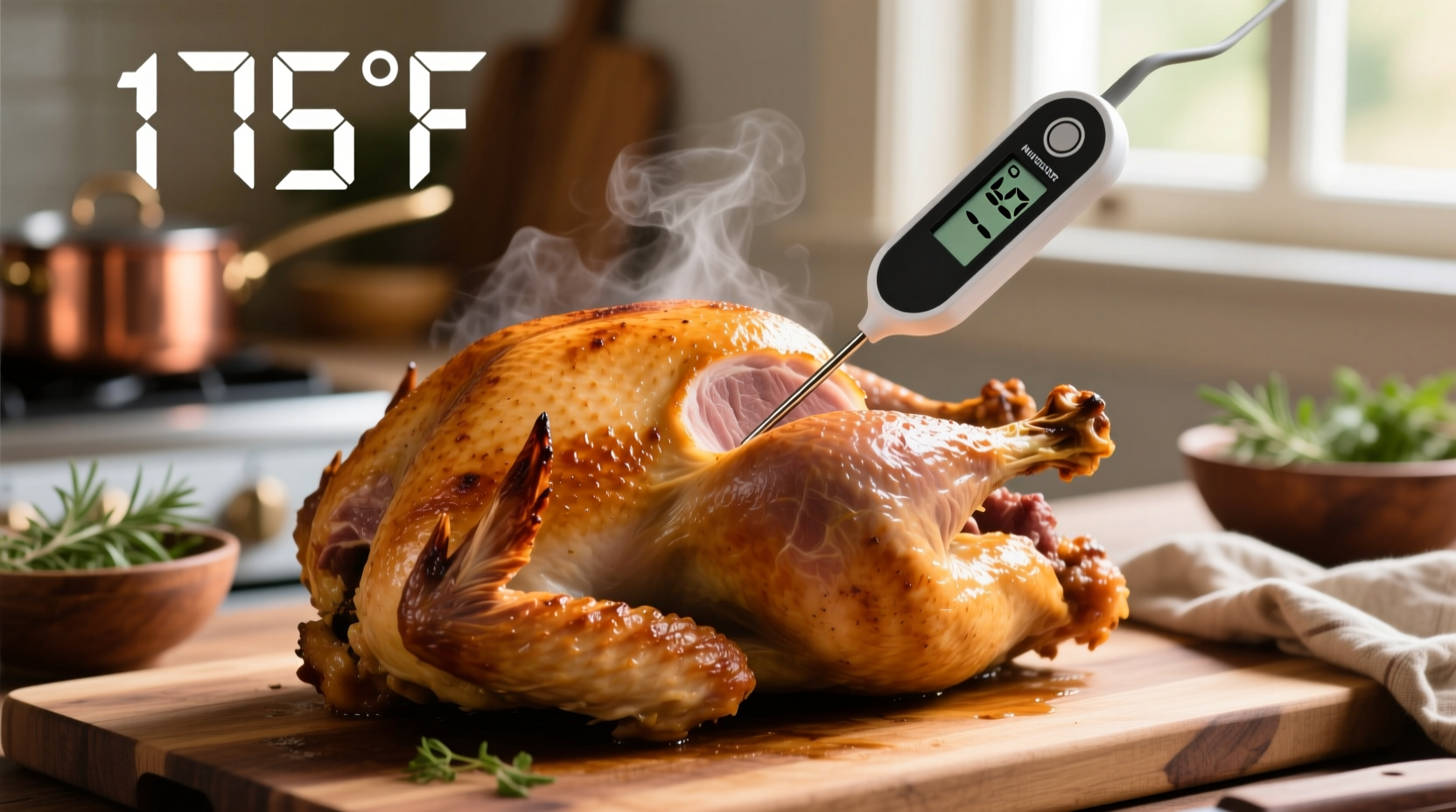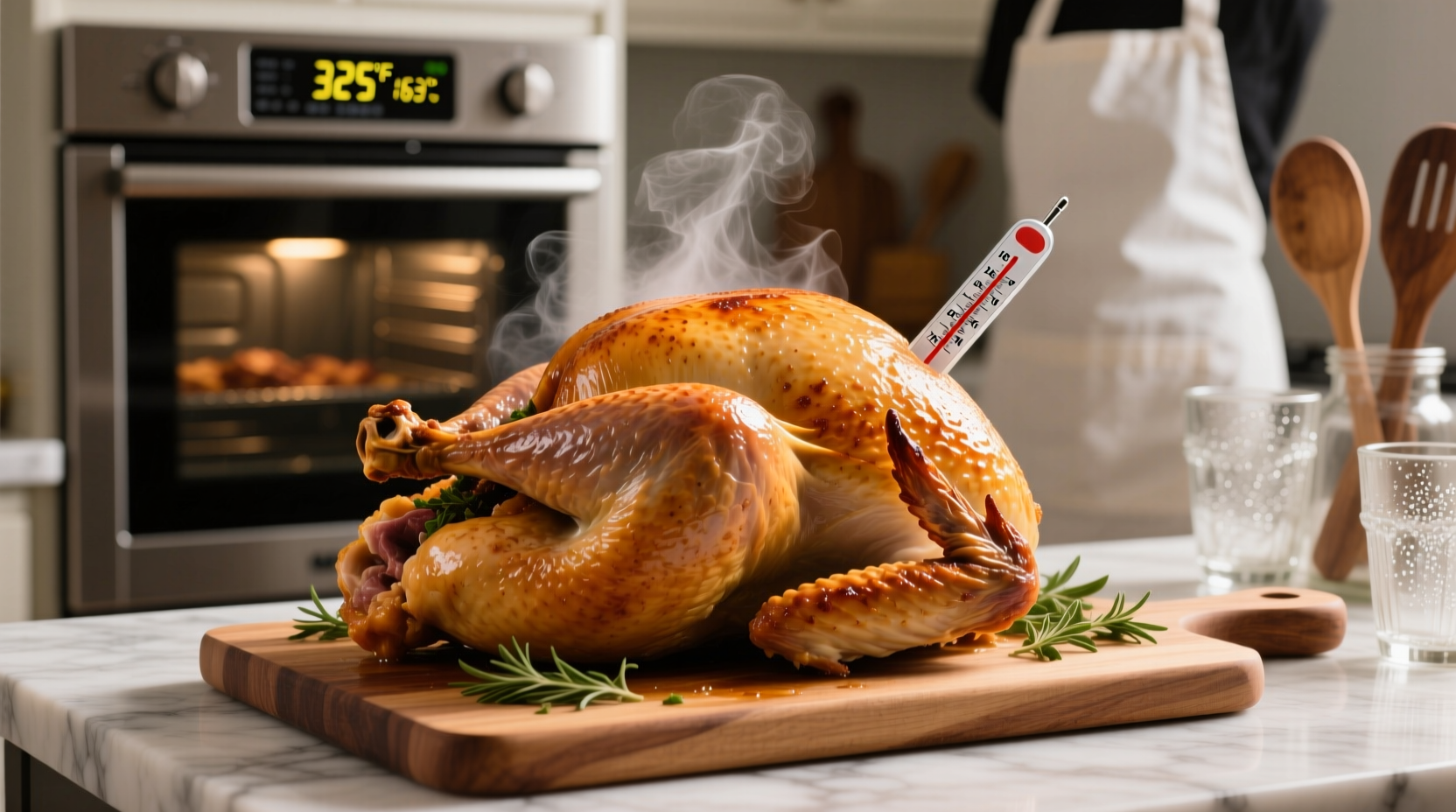When preparing your holiday centerpiece, getting the turkey temperature right isn't just about perfect texture—it's critical food safety. Undercooked poultry can harbor harmful bacteria like salmonella and campylobacter, while overcooked turkey becomes dry and disappointing. Let's explore exactly how to achieve that perfect balance of safety and succulence.
Why 165°F Is Your Turkey's Magic Number
The USDA Food Safety and Inspection Service has established 165°F (74°C) as the minimum safe internal temperature for poultry. This temperature destroys harmful pathogens that could cause foodborne illness. Unlike beef or pork, turkey doesn't have enough fat content to safely consume at lower temperatures.
| Part of Turkey | Safe Temperature | Why It Matters |
|---|---|---|
| Chest/Breast | 165°F (74°C) | Ensures white meat is safe without becoming dry |
| Thigh | 165°F (74°C) | Dark meat requires thorough cooking for safety |
| Wing Joint | 165°F (74°C) | Often the last area to reach safe temperature |
| Stuffing (if used) | 165°F (74°C) | Prevents bacterial growth in moist environment |
How to Properly Measure Turkey Temperature
Using a reliable food thermometer correctly is essential. Digital instant-read thermometers provide the most accurate results. Here's the proper technique:
- Insert the thermometer into the thickest part of the breast, avoiding bone
- Check the innermost part of the thigh and wing joint
- Take multiple readings in different spots
- Wait 10-15 seconds for the reading to stabilize
- Sanitize the thermometer probe between readings
Many home cooks make the mistake of checking temperature too early or only in one spot. Remember that heat distribution in a large bird like turkey isn't uniform—the breast cooks faster than the thigh, which is why multiple readings are crucial.
Oven Temperature vs. Internal Temperature: Understanding the Difference
When people ask what temperature to cook a turkey in oven, they're often confusing oven temperature with the required internal temperature. These are two different measurements:
- Oven temperature: The setting you use for your oven (typically 325°F-350°F)
- Internal temperature: The actual temperature inside the turkey meat (must reach 165°F)
Most food safety experts recommend roasting turkey at 325°F (163°C). This moderate heat allows the turkey to cook evenly without burning the exterior before the interior reaches safe temperatures. Higher temperatures (like 400°F+) can create beautifully browned skin but increase the risk of uneven cooking.
Estimated Cooking Times by Weight
While internal temperature is the only reliable indicator of doneness, these time estimates at 325°F can help with meal planning. Always verify with a thermometer regardless of cooking time:
- 8-12 pounds: 2¾ to 3 hours
- 12-14 pounds: 3 to 3¾ hours
- 14-18 pounds: 3¾ to 4¼ hours
- 18-20 pounds: 4¼ to 4½ hours
- 20-24 pounds: 4½ to 5 hours
These times assume an unstuffed turkey. Add approximately 30 minutes to these estimates if you're cooking stuffing inside the bird, as this creates a denser mass that requires more time to heat through.

The Critical Resting Period
Many home cooks overlook the importance of resting time after removing the turkey from the oven. During this 20-30 minute period:
- Internal temperature continues to rise 5-10°F (carryover cooking)
- Juices redistribute throughout the meat
- Proteins relax, resulting in more tender meat
- Skin stays crisp while interior remains moist
Cover the turkey loosely with foil during resting to maintain warmth without trapping too much moisture that would soften the skin.
Common Temperature Mistakes and How to Avoid Them
Even experienced cooks sometimes fall into these temperature traps:
- Mistake: Relying on pop-up timers
Solution: Use a digital thermometer instead—they often trigger at 180-185°F, resulting in overcooked breast meat - Mistake: Not checking multiple spots
Solution: Measure in breast, thigh, and wing joint—these areas cook at different rates - Mistake: Opening the oven too frequently
Solution: Minimize oven door openings to maintain consistent temperature (each opening drops oven temp by 25-50°F) - Mistake: Not calibrating your thermometer
Solution: Test your thermometer in ice water (should read 32°F/0°C) or boiling water (212°F/100°C at sea level)
Food Safety Timeline for Turkey Preparation
Understanding the complete temperature journey helps prevent foodborne illness. This timeline shows critical temperature points from refrigerator to table:
- Refrigeration: Keep turkey below 40°F (4°C) while thawing or storing
- Thawing: Never thaw at room temperature—use refrigerator (allow 24 hours per 4-5 pounds) or cold water method
- Danger Zone: Avoid keeping turkey between 40°F-140°F (4°C-60°C) for more than 2 hours (1 hour if room temperature exceeds 90°F)
- Cooking: Internal temperature must reach 165°F (74°C) throughout
- Serving: Keep hot turkey above 140°F (60°C) until serving
- Leftovers: Refrigerate within 2 hours, consume within 3-4 days
This temperature progression, documented by the USDA Food Safety and Inspection Service, demonstrates why monitoring throughout the entire cooking process matters—not just at the end. Bacteria multiply rapidly in the danger zone, making proper temperature management essential.
Troubleshooting Temperature Issues
Encountering problems with your turkey's temperature? Here's how to handle common scenarios:
- Problem: Breast reaches 165°F but thigh is still under 150°F
Solution: Cover breast with foil and continue cooking, checking thigh temperature every 15 minutes - Problem: Turkey is browning too quickly
Solution: Reduce oven temperature by 25°F and tent with foil - Problem: Turkey is taking much longer than estimated time
Solution: Verify oven temperature with an oven thermometer—many ovens run cooler than displayed - Problem: Internal temperature stalls around 150°F
Solution: This is normal (the "plateau" phase)—continue cooking patiently until it reaches 165°F
Final Temperature Verification Before Serving
Before carving your turkey, perform one last temperature check in multiple locations. The USDA recommends checking:
- The innermost part of the thigh
- The innermost part of the wing
- The thickest part of the breast
- Any stuffing (if cooked inside the bird)
If any area hasn't reached 165°F, return the turkey to the oven and check again in 15-20 minutes. Remember that the temperature will continue to rise slightly during resting.
Essential Tools for Perfect Turkey Temperature
While you don't need expensive equipment, these tools make temperature management easier:
- Digital instant-read thermometer (Thermapen-style)
- Oven-safe leave-in probe thermometer with alarm
- Thermometer calibration kit (ice and boiling water tests)
- Insulated cooler (for emergency resting if oven needed for sides)
Investing in a quality thermometer pays off in perfectly cooked turkey and peace of mind about food safety.











 浙公网安备
33010002000092号
浙公网安备
33010002000092号 浙B2-20120091-4
浙B2-20120091-4